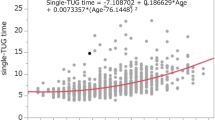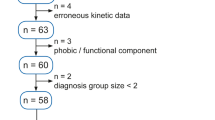Abstract
Aims: To study and compare both mean performance measures as well as intra-individual variability measures of stride length and reaction time in vulnerable recurrent and non-recurrent older fallers. Methods: Stride length during walking and walking while dual-tasking (GAITRite®) and choice reaction time (CANTAB®) were assessed in geriatric outpatients and their informal caregivers (n=60, ≥60 yrs). Logistic regression and Receiver Operating Characteristic (ROC) analysis were used to generate models with mean performance measures and intra-individual variability measures (coefficients of variation; CV=[sd/mean]×100)), as risk factors for recurrent falls. Results: Reaction-time CV was higher in recurrent fallers than in non-recurrent fallers: 21.3% [9.3–47.7] vs 15.8% [8.3–34.9] (p=0.04). Also, stride-length CV was higher in recurrent fallers during performance of the verbal fluency dual-task: 4.5% [1.2–31.4] vs 3.5% [0.9–9.7] (p=0.017). The model with CVs provided an explained variance of 23.7%, and an area under the curve (AUC) of 0.73, which was higher than that of the model including mean performance measures (8.6% and 0.65 respectively). Conclusions: Older recurrent fallers are characterized by increased within-task variability in reaction time and stride length while dualtasking. In addition, variability in performance is a more sensitive measure in discrimination of recurrent falls than mean performance itself, suggesting deterioration in neurocognitive regulation mechanisms as part of the causal pathway for recurrent falls.
Similar content being viewed by others
References
Tinetti ME, Kumar C. The patient who falls: “It’s always a tradeoff”. JAMA 2010; 303: 258–66.
Bloem BR, Steijns JA, Smits-Engelsman BC. An update on falls. Curr Opin Neurol 2003; 16: 15–26.
Rubenstein LZ. Falls in older people: epidemiology, risk factors and strategies for prevention. Age Ageing 2006; 35 (Suppl 2): ii37–41.
Hausdorff JM, Edelberg HK, Mitchell SL, Goldberger AL, Wei JY. Increased gait unsteadiness in community-dwelling elderly fallers. Arch Phys Med Rehabil 1997; 78: 278–83.
Hausdorff JM, Rios DA, Edelberg HK. Gait variability and fall risk in community-living older adults: a 1-year prospective study. Arch Phys Med Rehabil 2001; 82: 1050–6.
Maki BE. Gait changes in older adults: predictors of falls or indicators of fear. J Am Geriatr Soc 1997; 45: 313–20.
Nakamura T, Meguro K, Sasaki H. Relationship between falls and stride length variability in senile dementia of the Alzheimer type. Gerontology 1996; 42: 108–13.
Srikanth V, Beare R, Blizzard L et al. Cerebral white matter lesions, gait, and the risk of incident falls: a prospective populationbased study. Stroke 2009; 40: 175–80.
Herman T, Mirelman A, Giladi N, Schweiger A, Hausdorff JM. Executive control deficits as a prodrome to falls in healthy older adults: a prospective study linking thinking, walking, and falling. J Gerontol A Biol Sci Med Sci 2010; 65: 1086–92.
Woollacott M, Shumway-Cook A. Attention and the control of posture and gait: a review of an emerging area of research. Gait Posture 2002; 16: 1–14.
Beauchet O, Annweiler C, Allali G, Berrut G, Dubost V. Dual taskrelated changes in gait performance in older adults: a new way of predicting recurrent falls? J Am Geriatr Soc 2008; 56: 181–2.
Kressig RW, Herrmann FR, Grandjean R, Michel JP, Beauchet O. Gait variability while dual-tasking: fall predictor in older inpatients? Aging Clin Exp Res 2008; 20: 123–30.
Springer S, Giladi N, Peretz C, Yogev G, Simon ES, Hausdorff JM. Dual-tasking effects on gait variability: the role of aging, falls, and executive function. Mov Disord 2006; 21: 950–7.
Alexander NB, Hausdorff JM. Guest editorial: linking thinking, walking, and falling. J Gerontol A Biol Sci Med Sci 2008; 63: 1325–8.
Beauchet O, Annweiler C, Dubost V et al. Stops walking when talking: a predictor of falls in older adults? Eur J Neurol 2009; 16: 786–95.
Verghese J, Buschke H, Viola L et al. Validity of divided attention tasks in predicting falls in older individuals: a preliminary study. J Am Geriatr Soc 2002; 50: 1572–6.
van Iersel MB, Kessels RP, Bloem BR, Verbeek AL, Olde Rikkert MG. Executive functions are associated with gait and balance in community-living elderly people. J Gerontol A Biol Sci Med Sci 2008; 63: 1344–9.
Hausdorff JM, Doniger GM, Springer S, Yogev G, Simon ES, Giladi N. A common cognitive profile in elderly fallers and in patients with Parkinson’s disease: the prominence of impaired executive function and attention. Exp Aging Res 2006; 32: 411–29.
Camicioli RM, Wieler M, de Frias CM, Martin WR. Early, untreated Parkinson’s disease patients show reaction time variability. Neurosci Lett 2008; 441: 77–80.
Ferrucci L, Guralnik JM, Studenski S, Fried LP, Cutler GB Jr, Walston JD. Designing randomized, controlled trials aimed at preventing or delaying functional decline and disability in frail, older persons: a consensus report. J Am Geriatr Soc 2004; 52: 625–34.
Kempen GI, Miedema I, Ormel J, Molenaar W. The assessment of disability with the Groningen Activity Restriction Scale. Conceptual framework and psychometric properties. Soc Sci Med 1996; 43: 1601–10.
Robbins TW, James M, Owen AM, Sahakian BJ, McInnes L, Rabbitt P. Cambridge Neuropsychological Test Automated Battery (CANTAB): a factor analytic study of a large sample of normal elderly volunteers. Dementia 1994; 5: 266–81.
Menz HB, Latt MD, Tiedemann A, Mun San KM, Lord SR. Reliability of the GAITRite walkway system for the quantification of temporo-spatial parameters of gait in young and older people. Gait Posture 2004; 20: 20–5.
DeLong ER, DeLong DM, Clarke-Pearson DL. Comparing the areas under two or more correlated receiver operating characteristic curves: a nonparametric approach. Biometrics 1988; 44: 837–45.
Shumway-Cook A, Brauer S, Woollacott M. Predicting the probability for falls in community-dwelling older adults using the Timed Up & Go Test. Phys Ther 2000; 80: 896–903.
Stuss DT, Murphy KJ, Binns MA, Alexander MP. Staying on the job: the frontal lobes control individual performance variability. Brain 2003; 126: 2363–80.
Bellgrove MA, Hester R, Garavan H. The functional neuroanatomical correlates of response variability: evidence from a response inhibition task. Neuropsychologia 2004; 42: 1910–6.
Baddeley A. Working memory. Curr Biol 2010; 20: R136–40.
Beauchet O, Dubost V, Gonthier R, Kressig RW. Dual-task-related gait changes in transitionally frail older adults: the type of the walking- associated cognitive task matters. Gerontology 2005; 51: 48–52.
Verghese J, Kuslansky G, Holtzer R et al. Walking while talking: effect of task prioritization in the elderly. Arch Phys Med Rehabil 2007; 88: 50–3.
Zimmerman ME, Lipton RB, Pan JW, Hetherington HP, Verghese J. MRI- and MRS-derived hippocampal correlates of quantitative locomotor function in older adults. Brain Res 2009; 1291: 73–81.
Guimaraes RM, Isaacs B. Characteristics of the gait in old people who fall. Int Rehabil Med 1980; 2: 177–80.
Pluijm SM, Smit JH, Tromp EA et al. A risk profile for identifying community-dwelling elderly with a high risk of recurrent falling: results of a 3-year prospective study. Osteoporos Int 2006; 17: 417–25.
Rabbitt P, Osman P, Moore B, Stollery B. There are stable individual differences in performance variability, both from moment to moment and from day to day. Q J Exp Psychol A 2001; 54: 981–1003.
Hultsch DF, MacDonald SW, Dixon RA. Variability in reaction time performance of younger and older adults. J Gerontol B Psychol Sci Soc Sci 2002; 57: 101–15.
Hauer K, Lamb SE, Jorstad EC, Todd C, Becker C. Systematic review of definitions and methods of measuring falls in randomised controlled fall prevention trials. Age Ageing 2006; 35: 5–10.
Ganz DA, Higashi T, Rubenstein LZ. Monitoring falls in cohort studies of community-dwelling older people: effect of the recall interval. J Am Geriatr Soc 2005; 53: 2190–4.
Author information
Authors and Affiliations
Corresponding author
Rights and permissions
About this article
Cite this article
Reelick, M.F., Kessels, R.P.C., Faes, M.C. et al. Increased intra-individual variability in stride length and reaction time in recurrent older fallers. Aging Clin Exp Res 23, 393–399 (2011). https://doi.org/10.1007/BF03337764
Received:
Accepted:
Published:
Issue Date:
DOI: https://doi.org/10.1007/BF03337764




